Fill in the trophic levels (1,2,3 and 4) in th eboxes provided in the figure.
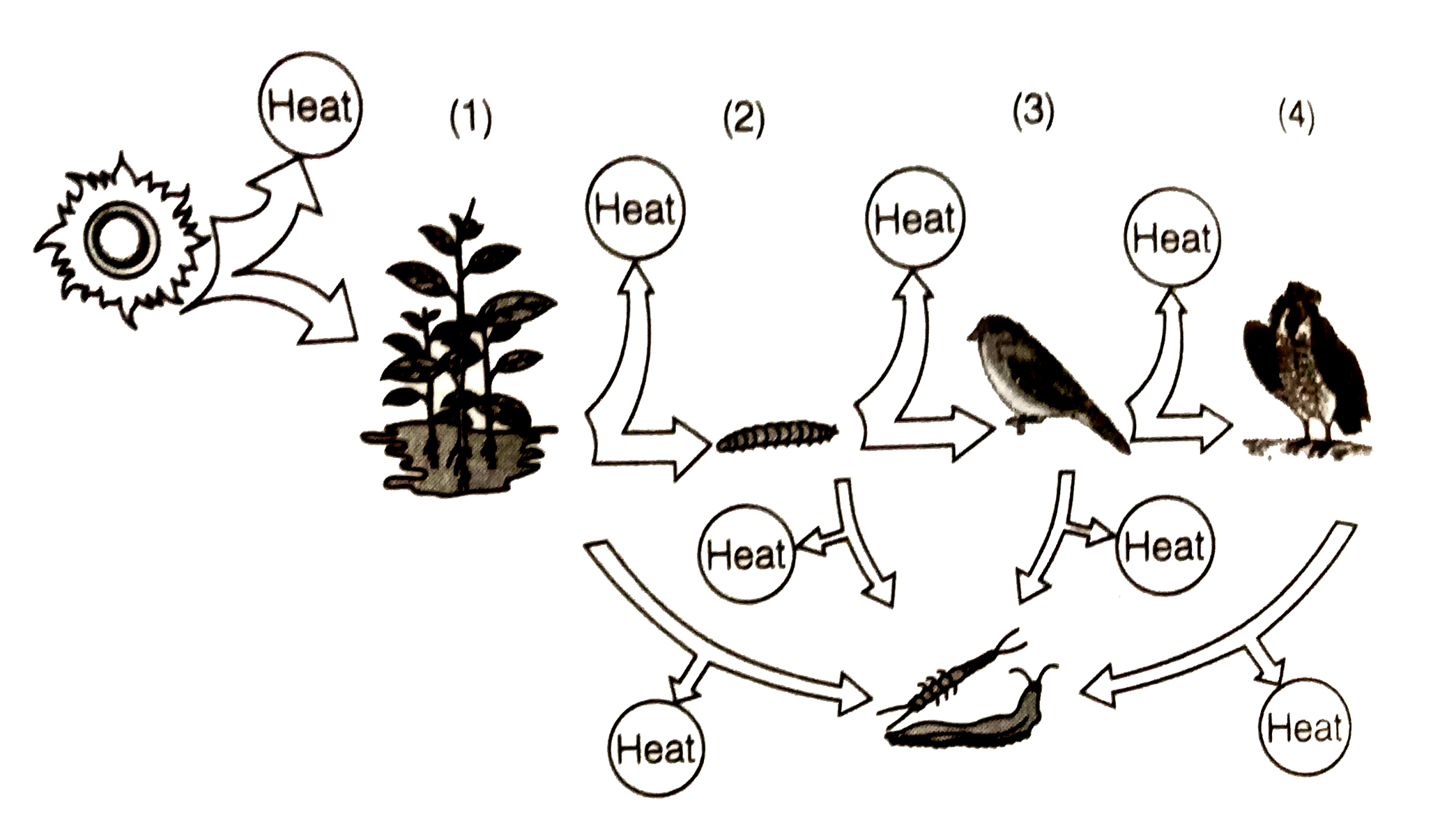
(1) = First Trophic level i.e. Producer
(2) = Second Trophic level i.e. Herbivore
(Primary consumer).
(3) = Third Trophic level i.e. Small carnivorous bird (Secondary consumer)
(4) = Fourth Trophic level i.e. Large
carnivorous bird (Tertiary consumer)
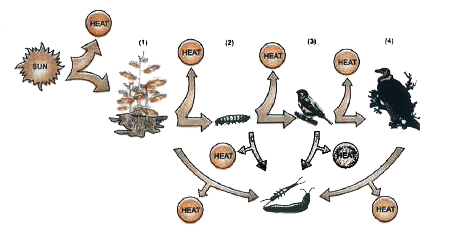
Topper's Solved these Questions
- BOOK - MODERN PUBLICATIONCHAPTER - ECOSYSTEM EXERCISE - NCERT Exemplar Problems (D. LONG ANSWER TYPE QUESTIONS)11videos
ECOSYSTEM
- BOOK - MODERN PUBLICATIONCHAPTER - ECOSYSTEM EXERCISE - Higher Order Thinking Skills & Brain Twisting (Very Short Answer Questions)10videos
ECOSYSTEM
- BOOK - MODERN PUBLICATIONCHAPTER - ECOSYSTEM EXERCISE - NCERT Exemplar Problems (B. VERY SHORT ANSWER TYPE QUESTIONS)19videos
ECOSYSTEM
- BOOK - MODERN PUBLICATIONCHAPTER - BIOTECHNOLOGY AND ITS APPLICATIONSEXERCISE - CHAPTER PRACTICE TEST (SECTION - E)2videos
BIOTECHNOLOGY AND ITS APPLICATIONS
- BOOK - MODERN PUBLICATIONCHAPTER - EVOLUTIONEXERCISE - CHAPTER PRACTICE TEST (SECTION-D)(CASE-BASED SHORT ANWER )(THREE MARK EACH)2videos
EVOLUTION
Similar Questions
What will be the amount of energy available to the organisms of the 2nd trophic level of a food chain, if the energy available at the first trophic level is l 0,000 joules?
View SolutionWhat will be the amount of energy available to the organisms of the 2nd trophic level of a food chain, if the energy available at the first trophic level is l 0,000 joules?
View Solution
Knowledge Check
- Question 1 - Select One
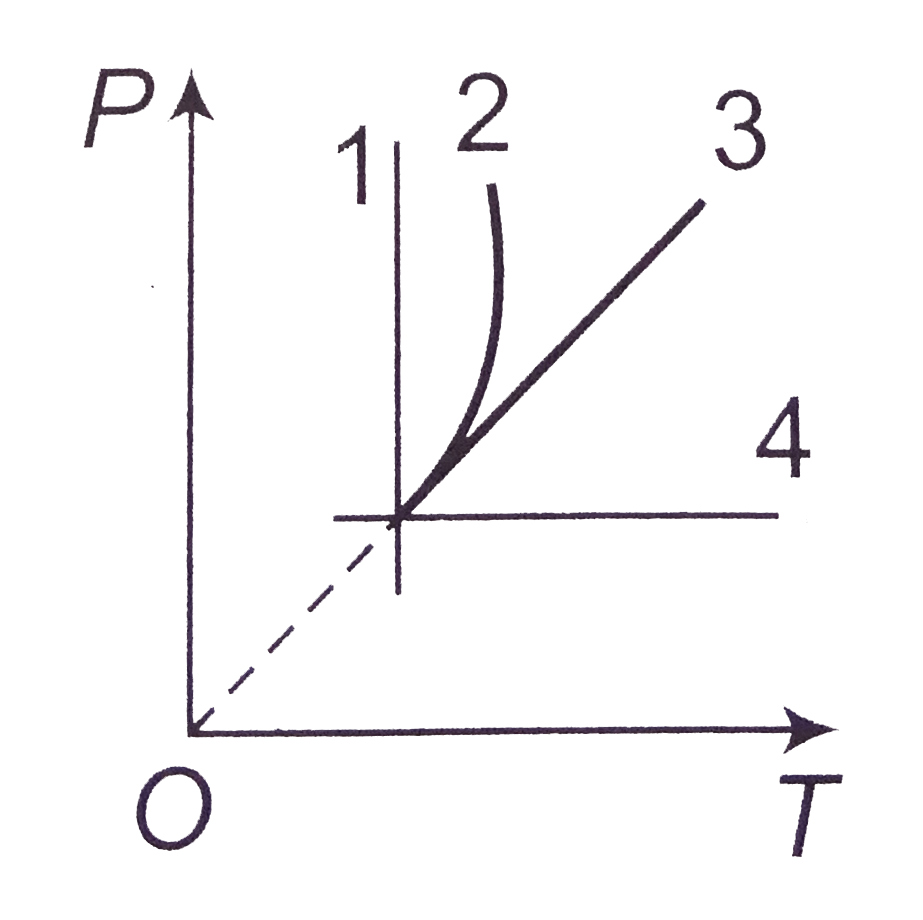
In the figure shown, the processes leveled 1,2,3 and 4 areAisothermal, adiabatic, isobaric, isochoricBisothermal, adiabatic, isochoric, isobaricCadiabatic, isothemal, isobaric, isochoricDadiabatic, isobaric, isothermal, isochoric
(a) Name an ideal pyramid existing in an ecosystem. Construct it up to its three trophic levels along with their names. (b) The sun provides 1,000,000 J of sunlight (solar energy) to an ecosystem. Write the amount of energy that is available to the first and third trophic levels, respectively.
View SolutionFood chains and the energy flow within an ecosystem provide an important understanding of contingencies and mutual dependencies of organisms. The given below flow chart depicts the energy flow within some members of a grassland ecosystem. The grass in the below ecosystem transducer 120,000 J of sunlight and fixes it into 12,000 J of energy. It is established that 90% of the energy of one trophic level is not passed to the next trophic level. Further assume that the energy transferred from one trophic level to the next is equally shared among the different organisms at that trophic level.
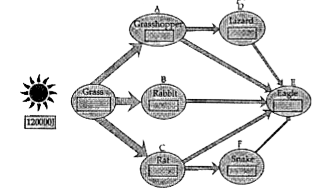
Based on the above information, indicate the amount of energy that an organism C may have received from an organism from the previous trophic level.View SolutionFood chains and the energy flow within an ecosystem provide an important understanding of contingencies and mutual dependencies of organisms. The given below flow chart depicts the energy flow within some members of a grassland ecosystem. The grass in the below ecosystem transducer 120,000 J of sunlight and fixes it into 12,000 J of energy. It is established that 90% of the energy of one trophic level is not passed to the next trophic level. Further assume that the energy transferred from one trophic level to the next is equally shared among the different organisms at that trophic level.
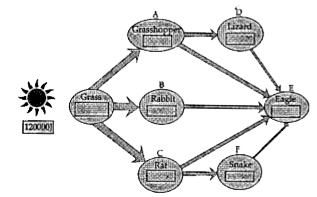
Tropic levels are formed by which of the following components?View SolutionFood chains and the energy flow within an ecosystem provide an important understanding of contingencies and mutual dependencies of organisms. The given below flow chart depicts the energy flow within some members of a grassland ecosystem. The grass in the below ecosystem transducer 120,000 J of sunlight and fixes it into 12,000 J of energy. It is established that 90% of the energy of one trophic level is not passed to the next trophic level. Further assume that the energy transferred from one trophic level to the next is equally shared among the different organisms at that trophic level.
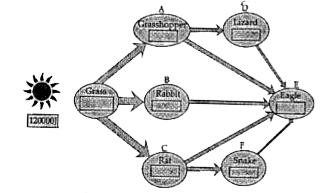
Which organism acts as both the secondary consumer and the tertiary consumer?View SolutionFood chains and the energy flow within an ecosystem provide an important understanding of contingencies and mutual dependencies of organisms. The given below flow chart depicts the energy flow within some members of a grassland ecosystem. The grass in the below ecosystem transducer 120,000 J of sunlight and fixes it into 12,000 J of energy. It is established that 90% of the energy of one trophic level is not passed to the next trophic level. Further assume that the energy transferred from one trophic level to the next is equally shared among the different organisms at that trophic level.
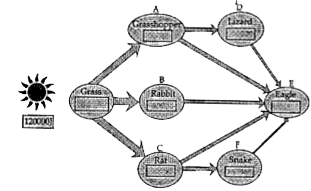
How many food chains are present in the food web depicted above?View SolutionExercise - 4 Level 1 and 2
View SolutionFood chains and the energy flow within an ecosystem provide an important understanding of contingencies and mutual dependencies of organisms. The given below flow chart depicts the energy flow within some members of a grassland ecosystem. The grass in the below ecosystem transducer 120,000 J of sunlight and fixes it into 12,000 J of energy. It is established that 90% of the energy of one trophic level is not passed to the next trophic level. Further assume that the energy transferred from one trophic level to the next is equally shared among the different organisms at that trophic level.
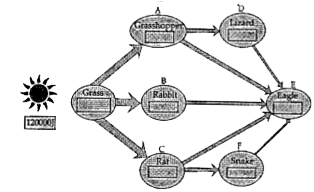
In the food web depicted above, identify the most energy efficient link for tertiary consumer.View Solution

